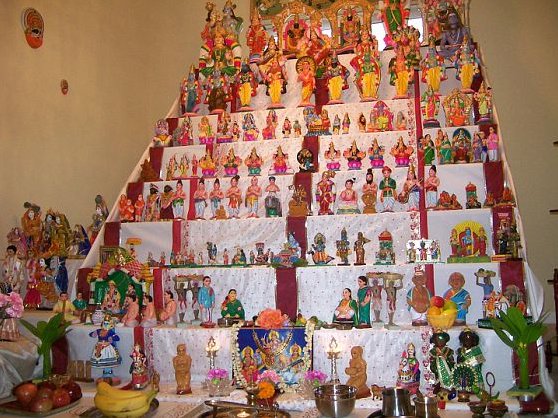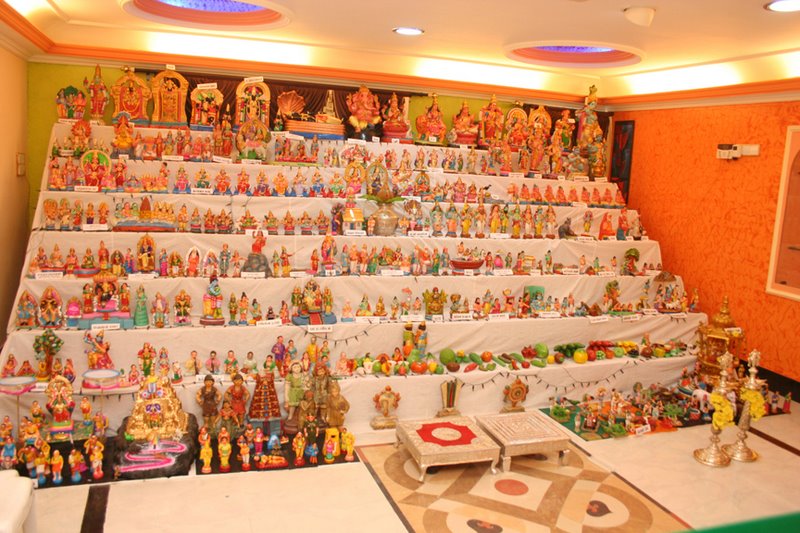Bommai Kolu / Bomma Golu | Navaratri celebrations in Tamil Nadu
In Tamil Nadu Navratri is celebrated in a unique way. The festival is celebrated for ten days and three days are dedicated to the worship of each of the three goddesses – Lakshmi, Durga and Saraswati. Celebrations conclude on the 10th day Vijayadashami (the day of victory).

The making of bommai kolu is the most important aspect of Navaratri celebrations in Tamil Nadu.
Bomma Golu or Bommai Kolu is the most beautiful aspect of Navratri celebrations in the Tamil Nadu. Bomma means doll. Bomma Golu is a display of dolls and figurines on wooden steps made for this purpose. Actually, this display of dolls representing various gods and goddesses is a customary aspect of the Navratri celebrations in Karnataka, Tamil Nadu and Andhra Pradesh.
Rituals
On the first day of Navaratri (October 2, 2016), a Ganapathi puja is performed first. Afterwards an elderly male or female member of the family performs a ritual called Kalasa Avahanam. This is done to invite the Goddesses Lakshmi, Saraswati and Parvati (Durga) into the home. After this ritual, the golu is built using 3, 5, 7, 9 or 11 (all odd numbers) wooden planks. It is basically a rack with many tiers. Once the golu/kolu is ready, it covered with a piece of fabric. It is then adorned with dolls, toys and figurines.
Larger idols and dolls representing deities are usually displayed on the top steps. The dolls that are displayed on the golu need not necessarily of gods. Actually, any doll that a girl would have played with may be displayed. Below the idols of gods and goddesses, dolls representing saints or heroes may be displayed. Dolls representing worldly institutions and activities like marriage, children, music or temples may be displayed below that. Businessmen are usually represented by the Chettiar set of dolls. Chettiars are the traditional business community of Tamil Nadu.

A beautiful bomma golu made on the occasion of Navaratri.
It is also a traditional practice to include wooden figurines of a bride and groom (Marapacchi Bommai) together. These figurines are usually made of teak, sandalwood or rosewood. They are adorned with new clothes each year before being displayed on the golu. In many parts of South India, when a girl gets married, her parents present her with dolls of a bride and groom dressed in wedding attire. The girl is expected to start the tradition of Bommai Golu in her new home with these dolls. These dolls symbolize marital bliss, fertility and prosperity. They are also the first dolls in a bride’s Golu collection. These dolls and figurines are passed from one generation to another. It is customary to add a few dolls to the collection each year.
In the evenings women invite other women in their neighborhood to each other’s homes to see the Golu. They also exchange sweets and gifts. A beautiful rangoli is made and an oil lamp is lit in its middle. A puja is performed and food items prepared are first offered to the goddess and then distributed to the guests.
On the 9th day of the festival (Mahanavami October 10, 2016), a special puja is offered to Goddess Saraswati. Musical instruments and books are placed in front of her image in Puja room and worshiped with great reverence.
Vijayadasami, the 10th day, is the most important day of the festival. It was on this day Goddess Durga killed the demon Mahishasur. Vijayadashami celebrates the victory of good over evil and is the most auspicious day for Hindus. It is a great day to start new ventures or initiate kids into learning. In the neighboring state of Kerala this initiation into learning is the most important aspect of Navaratri celebrations. On the evening of Vijayadasami, one of the dolls is put to sleep symbolically. Then Kalasa (A ceremonial jar containing fresh water. It is covered with a coconut and mango leaves) is moved towards the north and that marks the end of that year’s Navratri celebrations. Prayers are offered to the goddess and the golu is dismantled. The dolls are removed and packed for next year.
Golu is essentially the assembly of Goddess Durga. It includes idols representing gods, goddesses, bride, groom, animals, businessmen and other worldly activities and institutions.